
Traditionally, healthcare organizations and physicians have had a straightforward arrangement: the more hours a physician worked and the more patients they saw, the greater their earning potential. Unfortunately, this model encourages long hours and lends itself to physician burnout. Perhaps that’s one explanation for the seismic, generational shift in physicians valuing a better work-life balance more. Here’s why healthcare organizations must provide flexible physician staffing if they want to succeed in the future.
Physicians value work-life balance more than ever
Physicians in every career stage say better work-life balance was their top motivation for making a career change, according to the 2024 CHG Healthcare Job Change Survey.
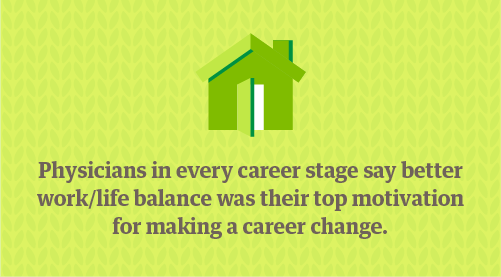
Late-career physicians want to scale back without losing financial ground, while early-career physicians simply value flexibility more than compensation. In fact, 91% of respondents in the CHG Resident Career Planning Study cited work-life balance as a top job factor, compared to 83% who listed annual salary.
“The last of the millennials are finally trained, exiting residency, and entering the workforce. We are also seeing the beginning of the next generation of physicians, and the priorities are different,” says Austin Chatlin, managing director of CHG’s Advisory Services. Their priority, he says, “is definitely not to work 60 hours a week and make as much money as possible.”
When it comes to hiring physicians, “the organization that's going to win is the organization that provides that flexibility in a way that their market competitors do not,” Chatlin says.
Change is hard — but worth the effort
Flexibility is not easy to build into traditional healthcare schedules, which is why change has been so slow and hard fought. It’s much easier to slot X number of physicians into Y number of standard shifts than to plan for variability.
For example, a physician may request a four-day workweek. “You would be surprised how many organizations will say, ‘No, we cannot accommodate that.’ There needs to be a mindset shift around how you create the right FTE and schedule model for these groups of physicians,” Chatlin says.
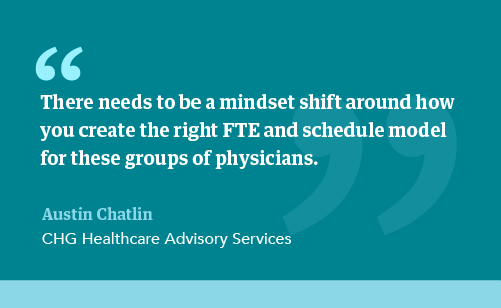
A common objection is that if you allow this kind of flexibility for one physician, you’ll have to allow it for all. “So do it for all,” Chatlin says. “This is the provider pool that you have. You need to meet them where they're currently at.”
When healthcare organizations refuse to accommodate flexibility when hiring physicians, they lose out on talented physicians who will simply go somewhere else. If an organization is struggling to fill positions, it forfeits revenue for as long as it takes to fill them.
Failing to provide flexibility may also contribute to increased burnout and poor physician retention.
“If you hire a recent resident graduate and you work them to death, after their first contract is up and you're ready to sign that new agreement, they’ll say, ‘No, I'm not going to do that.’ Well, you just wasted a couple hundred thousand dollars in costs,” says Chatlin. On top of that, “now you’ll have to spend on recruiting a new physician. Depending on the healthcare system, it costs around $80 to $120,000 to complete a search.”
Hire physicians faster: 8 ways to reduce your days to fill
What does flexibility for physicians look like?
Flexibility is not one-size-fits-all — that’s the whole point. A four-day workweek is just one example. Here are others:
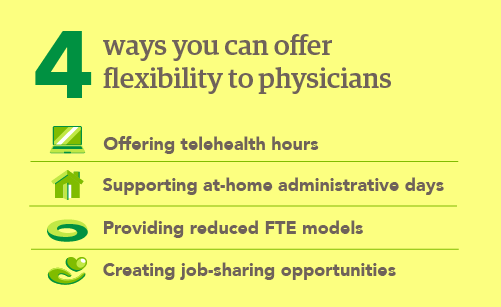
- Offering telehealth hours
- Supporting at-home administrative days
- Providing reduced FTE models
- Creating job-sharing opportunities
When posting a new position, Chatlin advises organizations to determine if it needs to be a full-time position or if a reduced FTE is possible. If the position could support an 0.8 or .06 FTE, “that will open up the recruiting pipeline of available candidates that you would be able to choose from,” he says. “And then your recruitment team will see more success in their searches.”
Change your physician compensation models
Late-career physicians want flexibility just as much as their early-career colleagues. However, they may find themselves tied into a compensation model that does not support flexibility or reduced hours.
For many physicians, as much as half their compensation — in the form of bonuses — is linked to patient volume through a relative value unit (RVU) model. “As a late-career physician, you do not want to reduce those RVUs, because your RVUs and your production are tied to your compensation directly,” says Chatlin. A physician might want to go part time or even retire but may feel shackled by their compensation model.
“The general solution is you have to change the model in which you pay and schedule your physicians, especially when you consider the two ends of the spectrum — the early-career and the late-career physicians,” he says. “On both ends of that spectrum, the number one thing that providers want is flexibility. It's work-life balance. But what work-life balance really means is flexibility. It's flexibility in how they work, how much they work, and the care delivery model in which they work.”
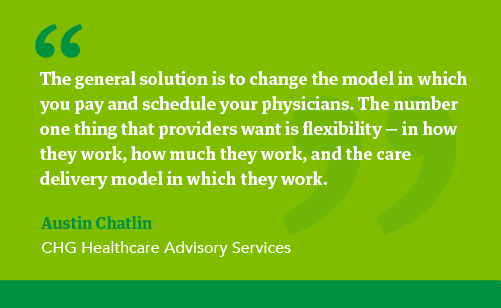
Get creative: 7 ways to shorten the recruiting cycle for hard-to-fill physician specialties
Flexibility may cost more upfront but will make recruiting easier
Reformulating compensation models to accommodate flexibility will increase labor expenses, says Chatlin. With labor being the number one cost for healthcare organizations, resistance to anything that would increase that expense is natural.
“Is it going to be more expensive? Yes. But is it going to be more expensive than the alternative, which is not having a provider there in time? No, absolutely not,” Chatlin says.
When an organization is focused on retaining or hiring physicians, offering flexibility is no longer a choice, he says. “Because you're going to experience a situation where you don't have any providers left — and that is so much worse for your bottom line than eating the increased labor cost.”
In fact, being known as an employer that offers flexibility will attract physicians, reducing staff openings and shortages.
“You can then increase your success by proactively reaching out to certain providers because now you have something nobody else has. You have an organizational differentiator that your market competitors don't have,” Chatlin says. “You want to be the place where people choose to work.”
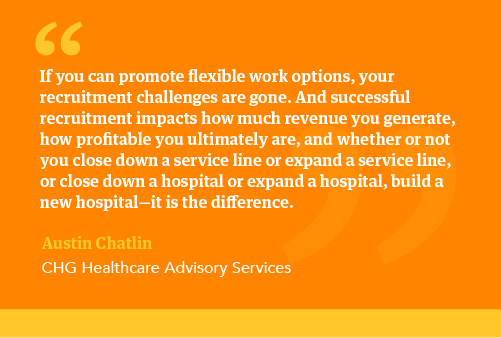
“If you can promote flexible work options, your recruitment challenges are gone,” he says. “And successful recruitment impacts how much revenue you generate, how profitable you ultimately are, and whether or not you close down a service line or expand a service line, or close down a hospital or expand a hospital, build a new hospital — it is the difference.”
Click image below to download a PDF:
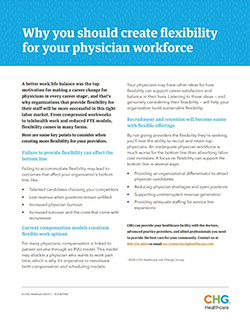
CHG can provide your healthcare facility with the doctors, advanced practice providers, and allied professionals you need to provide the best care for your community. Contact us at 866.570.9920 or email ecs.contact@chghealthcare.com.